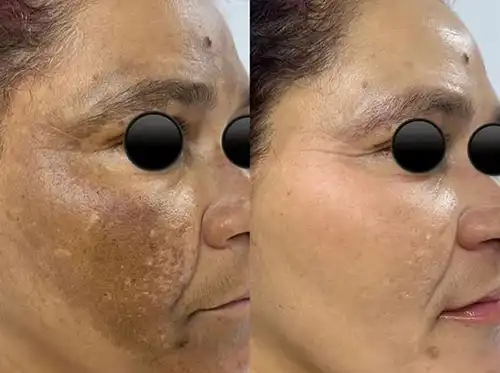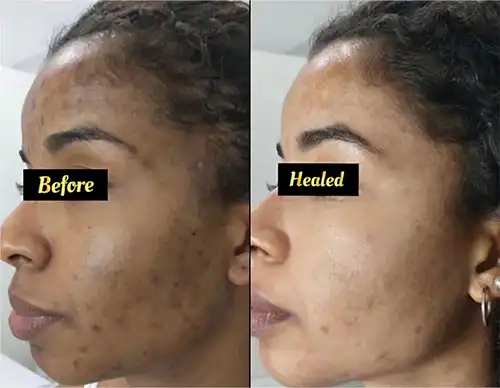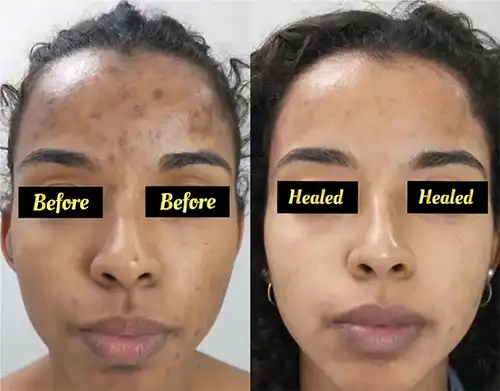Melasma Laser Treatment in Nairobi, Kenya
Melasma laser treatment is a cosmetic procedure used to reduce or remove melasma, a skin condition characterized by dark, patchy pigmentation typically found on the face. Here’s an overview of what to expect:
Laser treatment targets melanin (the pigment responsible for dark spots) in the affected areas using focused light energy. The energy breaks down the pigment, allowing the body to gradually remove it.
What Causes Melasma
Melasma is caused by an overproduction of melanin, the pigment responsible for skin color. This excess pigment accumulates in patches on the skin, resulting in dark or discolored areas. Several factors can trigger or worsen melasma:
- Hormonal Changes
– Hormones play a significant role in melasma development, especially in women.
– Pregnancy: Known as “chloasma” or “mask of pregnancy,” melasma often appears due to elevated hormone levels during pregnancy.
– Birth Control Pills or Hormone Therapy: Hormonal medications can trigger melasma by increasing sensitivity to UV light. - Sun Exposure
– UV radiation is the leading cause of melasma.
– It stimulates melanocytes (pigment-producing cells) to produce more melanin.
– Prolonged sun exposure can worsen existing melasma or cause it to recur even after treatment. - Genetic Factors
– Family history of melasma increases the likelihood of developing the condition.
– Certain ethnic groups, such as Hispanics, Asians, and Middle Eastern individuals, are more prone due to higher melanin levels in their skin. - Skin Inflammation: Previous skin irritation, injuries, or conditions (e.g., acne, eczema) can lead to post-inflammatory hyperpigmentation resembling melasma.
- Certain Medications and Cosmetics
– Medications: Anti-seizure drugs, some antibiotics, and photosensitizing medications can trigger melasma.
– Cosmetics: Skincare products that irritate or sensitize the skin to sunlight may exacerbate the condition. - Heat and Infrared Light: Exposure to heat sources like ovens, saunas, or even laptops can activate melanocytes, contributing to melasma.
- Stress and Thyroid Disorders: Chronic stress and hypothyroidism may play a role in hormonal imbalances, indirectly contributing to melasma development.
Why Does Melasma Happen More in Women?
Melasma is predominantly seen in women because estrogen and progesterone—female sex hormones—stimulate melanocyte activity, especially under sun exposure.
Before undergoing any laser treatment, it’s essential to Consult with one of our qualified professional who can assess your skin condition and recommend the most appropriate treatment plan based on your individual needs and medical history. They can also discuss potential risks, benefits, and expected outcomes of melasma laser treatment.
Types of Melasma
Melasma can be classified into different types based on the depth of the pigment in the skin. Identifying the type is important for determining the most effective treatment.
- Epidermal Melasma
– Characteristics:
→ Pigment is located in the outermost layer of the skin (epidermis).
→ Appears as well-defined, dark brown patches.
→ More visible under a Wood’s lamp examination.
– Treatability:
→ Easier to treat with topical creams, chemical peels, or laser treatments. - Dermal Melasma
– Characteristics:
→ Pigment is deposited deeper in the dermis (second layer of skin).
→ Appears as light brown, bluish-gray, or grayish patches.
→ Poorly defined edges and not enhanced under a Wood’s lamp.
– Treatability:
→ More resistant to treatment and requires a combination of therapies like laser treatments and long-term maintenance. - Mixed-Type Melasma
– Characteristics:
→ Combination of epidermal and dermal pigmentation.
→ Patches appear dark brown, light brown, or gray in different areas.
→ Some areas are visible under a Wood’s lamp, while others are not.
– Treatability:
→ Moderately treatable with a mix of topical agents, chemical peels, and laser therapy. - Vascular Melasma
– Characteristics:
→ Involves blood vessels in addition to pigmentation.
→ May appear red or purple, with increased vascularity in affected areas.
→ Often seen alongside mixed-type melasma.
– Treatability:
→ Requires treatments targeting both pigmentation and vascular components, like lasers designed for blood vessels.
Additionally, melasma can be classified based on its distribution and underlying causes:
- Centrofacial Melasma: This is the most common type of melasma and typically affects the central areas of the face, including the cheeks, forehead, nose, upper lip, and chin. Centrofacial melasma is often associated with hormonal changes, sun exposure, and genetic factors.
- Malar Melasma: Malar melasma specifically affects the cheeks and is characterized by symmetrical patches of pigmentation on both sides of the face. This type of melasma is commonly associated with sun exposure and may occur in individuals with darker skin tones.
- Lateral Cheek Melasma: Lateral cheek melasma involves pigmentation on the sides of the cheeks, extending towards the temples. This type of melasma may be more prevalent in individuals with olive or darker skin tones and can be challenging to treat.
- Mandibular Melasma: Mandibular melasma affects the jawline and lower face, often extending from the corners of the mouth to the jawline. This type of melasma may be influenced by hormonal changes, sun exposure, and genetic predisposition.
Understanding the type and distribution of melasma is essential for developing an effective treatment plan tailored to each individual’s needs and skin characteristics. At Rebel Inks Tattoos, Tattoo Removal, and Body Piercings Parlour our professionals can provide a comprehensive evaluation and recommend the most appropriate treatment approach based on the specific type of melasma and underlying factors.
Melasma Laser Treatment Procedure
Laser treatment for melasma is a non-invasive procedure that targets and breaks down excess pigmentation in the skin. Here’s a detailed step-by-step guide to the process:
- Consultation and Assessment
– Our professional evaluates your skin type, the severity of melasma, and pigmentation depth.
– They may perform a Wood’s lamp examination to determine whether the pigmentation is epidermal, dermal, or mixed.
– Discuss your medical history and treatment goals to decide the most suitable laser type. - Preparation
– Skin Preparation: Your skin will be thoroughly cleansed to remove oils, dirt, or makeup.
– Eye Protection: You will wear protective eyewear to shield your eyes from the laser light.
– Optional Numbing Cream: A topical anesthetic may be applied to minimize discomfort, though most lasers cause only mild sensations. - Laser Treatment
– Our expert uses a handheld laser device to deliver focused light energy to the melanin in the affected areas.
– Commonly used lasers include:
→ Q-Switched Nd:YAG Lasers: Target deeper pigmentation.
→ Fractional Lasers: Address surface-level pigmentation.
→ Picosecond Lasers: Provide faster and precise results with less heat.
– Duration: A session typically lasts 20–30 minutes, depending on the size of the treated area. - Post-Treatment Care
– After the procedure, a soothing cream or gel is applied to reduce redness and inflammation.
– Sunscreen with SPF 50+ is essential to protect the treated skin from UV damage. - Follow-Up Treatments
– Number of Sessions:
→ Most individuals require 4–6 sessions spaced 4 weeks apart for optimal results.
→ Maintenance treatments may be necessary to prevent recurrence.
Types of Lasers used in Treatment of Melasma
Various types of lasers are used to treat melasma, each targeting pigmentation at different depths and with varying degrees of intensity. The choice of laser depends on the patient’s skin type, the depth of pigmentation, and the severity of the condition. Below are the most commonly used lasers for melasma treatment:
Q-Switched Nd:YAG Laser
- How It Works:
– Delivers high-intensity energy in short pulses to break down melanin into smaller particles that the body can eliminate.
– Targets deeper layers of pigmentation, making it effective for dermal or mixed melasma. - Benefits:
– Minimal damage to surrounding tissue.
– Suitable for most skin types, including darker tones. - Risks: May require multiple sessions for visible results.
Fractional Lasers (e.g., Fraxel)
- How It Works:
– Uses a fractionated light beam to create micro-injuries in the skin, stimulating natural healing and breaking up surface-level pigmentation.
– Primarily effective for epidermal melasma. - Benefits: Also improves skin texture and tone by promoting collagen production.
- Risks: May cause redness, peeling, or temporary sensitivity.
Picosecond Lasers
- How It Works:
– Emits ultra-short pulses of energy to shatter pigment particles more precisely and efficiently than other lasers.
– Minimal heat generated reduces the risk of post-inflammatory hyperpigmentation (PIH). - Benefits:
– Quicker recovery time compared to traditional lasers.
– Effective for both epidermal and dermal melasma. - Risks: May not be suitable for very dark skin tones without expert supervision.
IPL (Intense Pulsed Light)
- How It Works:
– Emits broad-spectrum light to target pigmentation in the epidermis.
– Often combined with other treatments for mild melasma. - Benefits:
– Non-invasive with minimal downtime.
– Can also address redness and vascular components. - Risks:
– Less effective for deeper pigmentation.
– Risk of hyperpigmentation in darker skin tones.
Ruby Laser
- How It Works:
– A short-pulsed laser with a wavelength specifically designed to target melanin.
– Primarily used for superficial pigmentation. - Benefits: Effective for light skin tones with mild melasma.
- Risks: Can cause irritation or hypopigmentation in darker skin tones.
Erbium:YAG Laser
- How It Works:
– Targets the top layers of the skin by removing pigmented cells.
– Often used as part of fractional laser systems. - Benefits: Promotes skin rejuvenation and even tone.
- Risks: Can lead to skin irritation or require longer downtime.
CO2 Laser
- How It Works:
– Ablative laser that removes the outer layers of the skin, promoting new skin growth.
– Rarely used for melasma due to the risk of scarring or hyperpigmentation. - Benefits: Effective for severe, stubborn cases when used cautiously.
- Risks: High risk of post-inflammatory hyperpigmentation in melasma patients.
Choosing the Right Laser
- Epidermal Melasma: Fractional lasers, IPL, or Q-Switched lasers.
- Dermal Melasma: Q-Switched Nd:YAG or Picosecond lasers.
- Mixed Melasma: Combination of Q-Switched Nd:YAG and fractional lasers.


Melasma Laser Treatment Aftercare
Aftercare is critical following melasma laser treatment to ensure proper healing, prevent complications, and maintain results. Here’s a detailed guide to post-treatment care:
- Protect Your Skin from the Sun
– Use Sunscreen:
→ Apply a broad-spectrum sunscreen with SPF 50+ daily, even indoors.
→ Reapply every 2–3 hours when outdoors.
– Avoid Direct Sunlight: Stay out of the sun, especially during peak hours (10 a.m.–4 p.m.).
– Wear Protective Clothing: Use wide-brimmed hats, sunglasses, and UV-protective clothing. - Avoid Heat and Sweating
– Stay away from saunas, steam rooms, and hot showers for at least 48 hours post-treatment.
– Avoid intense physical activity that causes sweating, as heat can worsen pigmentation. - Be Gentle with Your Skin
– Cleansing:
→ Use a mild, non-abrasive cleanser to wash your face.
→ Avoid scrubbing or using hot water.
– Moisturizing: Apply a soothing, hydrating moisturizer to keep your skin hydrated and prevent dryness or irritation. - Avoid Harsh Products
– Skip Exfoliants: Avoid scrubs, glycolic acid, salicylic acid, and retinol for at least 1–2 weeks.
– Avoid Skin Lighteners: Hold off on hydroquinone or bleaching agents until approved by your dermatologist. - Manage Redness and Sensitivity
– Use a cold compress or ice pack wrapped in a clean cloth to reduce redness or swelling.
– Apply dermatologist-recommended soothing creams (e.g., aloe vera or hydrocortisone) if necessary. - Stay Consistent with Follow-Up Treatments
– Multiple sessions are typically needed for optimal results.
– Follow your dermatologist’s recommendations on when to schedule subsequent treatments. - Avoid Makeup (Initially)
– Refrain from applying makeup for 24–48 hours post-treatment.
– When resuming, choose non-comedogenic and hypoallergenic products. - Monitor Your Skin
– Mild redness, swelling, or peeling is normal and typically subsides within a few days.
– Contact our professionals if you experience:
→ Severe redness or blistering.
→ Persistent pain or swelling.
→ Signs of infection (pus, oozing). - Long-Term Maintenance
– Continue using sunscreen daily to prevent recurrence.
– Consider maintenance treatments and a customized skincare routine to keep melasma at bay.
Lifestyle Tips
- Manage stress levels, as stress hormones can trigger melasma.
- Avoid medications or cosmetics that could irritate your skin or make it sensitive to light.
Schedule Appointment
Cost of Melasma Laser Treatment in Nairobi, Kenya
The cost of melasma laser treatment varies depending on factors such as the type of laser used, the severity of melasma, and the clinic’s location. Here’s a breakdown to give you a clearer idea:
Average Cost of Melasma Laser Treatment
- Per Session: Typically ranges from Ksh. 6,000 to Ksh. 10,000 per session.
- Total Cost: Since multiple sessions (4–6 on average) are usually required, the total cost can range from Ksh. 30,000 to Ksh. 50,000 or more.
Factors Influencing Cost
- Severity of Melasma: Larger or more severe patches may require longer treatment times or more sessions, increasing the cost.
- Location of the Parlour: Parlours in metropolitan areas or upscale neighborhoods may charge higher rates. Rebel Inks Tattoos, Tattoo Removal, and Body Piercings Parlour is located in the heart of the Central Business Disrict (CBD) in Nairobi, Kenya, and is easily accessible to both locals and foreigners in the country.
- Professionals’s Expertise: Treatments performed by highly experienced professionals or in specialized parlours may come at a premium. At Rebel Inks Tattoos, Tattoo Removal, and Body Piercings Parlour we have experienced professionals who offer quality and premium services.
- Parlour/ Studio Facilities and Technology: Parlours offering advanced technology and personalized care may charge more.
Additional Costs
- Consultation Fees: Ksh. 500 – Ksh, 1,000, though, At Rebel Inks Tattoos, Tattoo Removal, and Body Piercings Parlour we might waive this if you proceed with treatment.
- Skincare Products: Aftercare products like sunscreens, moisturizers, and serums can add Ksh. 1,000 – Ksh. 5,000
- Follow-Up Sessions: Maintenance treatments may be necessary to prevent recurrence, which incurs additional costs.
Benefits of Melasma Laser Treatment
Melasma laser treatment offers numerous benefits, particularly for individuals seeking an effective solution for persistent pigmentation issues. Below are the key advantages:
- Effective Reduction of Pigmentation
– Lasers target and break down excess melanin in the skin, reducing dark patches caused by melasma.
– Often effective for both epidermal (surface) and dermal (deep) pigmentation, depending on the laser type. - Quick and Precise Results
– Advanced laser technology allows for targeted treatment of affected areas without damaging surrounding healthy tissue.
– Results can often be seen after just a few sessions, with progressive improvement over time. - Non-Invasive and Minimal Downtime
– Most laser treatments are non-invasive, requiring no incisions or anesthesia.
– Recovery time is minimal, allowing patients to return to normal activities shortly after treatment. - Safe for Most Skin Types: Certain lasers, such as Q-Switched Nd:YAG and Picosecond lasers, are suitable for darker skin tones, where other treatments might pose risks of scarring or hyperpigmentation.
- Improves Overall Skin Texture
– In addition to reducing pigmentation, lasers can stimulate collagen production, improving skin texture, tone, and elasticity.
– Helps reduce the appearance of fine lines, pores, and uneven skin tone. - Long-Lasting Results with Proper Care: When combined with proper skincare and sun protection, laser treatments can provide long-term improvement and prevent melasma recurrence.
- Boosts Confidence: The reduction of visible pigmentation and an overall brighter complexion can significantly enhance self-esteem and confidence.
- Customizable Treatments
– Treatments can be tailored to individual skin types, the severity of melasma, and desired results.
– Various laser types allow dermatologists to address different depths of pigmentation effectively. - Combination with Other Therapies: Laser treatments can be combined with topical creams, chemical peels, or oral medications for comprehensive management of melasma.
- Minimal Discomfort: Advanced lasers, such as Picosecond lasers, offer a more comfortable experience with reduced heat and irritation compared to older laser technologies.
Are Laser Treatments Right for You?
- Laser treatment is ideal for individuals:
– With stubborn melasma that hasn’t responded to topical treatments or chemical peels.
– Seeking fast and noticeable improvements with minimal downtime.
Possible side effects of Melasma Laser Treatment
While melasma laser treatment is generally safe, there are potential side effects that can occur, especially if the treatment isn’t performed by an experienced dermatologist or if proper aftercare isn’t followed. Below are some possible side effects:
- Redness and Swelling
– What It Is: Common immediately after the procedure, especially for more aggressive lasers like fractional or Q-Switched Nd:YAG lasers.
– Duration: Usually subsides within 24 to 48 hours.
– Management: Cold compresses and soothing creams can help reduce discomfort. - Dryness and Peeling
– What It Is: As the skin heals, it may shed dead skin cells, resulting in peeling. This is more common with fractional lasers and CO2 lasers.
– Duration: Peeling can last for 3 to 7 days post-treatment.
– Management: Use a gentle, hydrating moisturizer and avoid picking at the skin to prevent scarring. - Hyperpigmentation (Post-Inflammatory Hyperpigmentation – PIH)
– What It Is:
→ Darkening of the skin in the treated area due to inflammation or trauma.
→ Can occur if the skin reacts excessively to the laser or if sun exposure is not avoided post-treatment.
– Risk Factors: More common in darker skin tones (Fitzpatrick skin types IV–VI).
– Management: PIH usually fades with time, but it can take several weeks to months. Using sun protection and avoiding further irritation is key. - Hypopigmentation (Lightening of Skin)
– What It Is: A decrease in pigment, resulting in lighter skin in the treated area.
– Risk Factors: This side effect is rare but may occur if the laser treatment is too aggressive or if the patient has sensitive skin.
= Management: Often temporary, but may require additional treatments or the use of topical agents to restore pigmentation. - Scarring
– What It Is: In rare cases, laser treatments can cause scars, especially if the skin is over-treated or not cared for properly post-procedure.
– Risk Factors: Risk is higher for aggressive lasers like CO2 or in patients who pick at their skin or don’t follow aftercare instructions.
– Management: Scarring can be minimized by following proper aftercare and avoiding sun exposure. - Infection
– What It Is: While uncommon, there’s a risk of infection if the skin is not properly protected or if bacteria enter the skin during recovery.
– Symptoms: Redness, pus, or pain in the treated area.
– Management: Keep the treated area clean, avoid touching it with dirty hands, and follow the dermatologist’s aftercare instructions. - Blistering or Crusting
– What It Is: Some patients, particularly those with sensitive skin, may experience blistering or crusting in the treated area.
– Risk Factors: More likely with CO2 lasers or aggressive fractional treatments.
– Management: Avoid picking or peeling the blisters to prevent scarring. Moisturize and follow the dermatologist’s instructions for proper care. - Sensitivity to Sunlight
– What It Is: The treated skin may be more sensitive to UV rays, increasing the risk of sunburn or recurrence of melasma if exposed to the sun.
– Duration: This sensitivity can last for weeks after the treatment.
– Management: Use a high-SPF sunscreen and avoid direct sun exposure during recovery. - Temporary Skin Sensitivity or Discomfort
– What It Is: Some patients may experience tingling, tightness, or mild discomfort in the treated area, especially within the first few days after treatment.
– Management: This sensation usually subsides within a few hours to days and can be managed with soothing creams.
When to Seek Medical Attention
- If you experience excessive redness, pain, fever, or any signs of infection, contact your dermatologist immediately.
- If you notice any unusual or persistent side effects, your dermatologist may adjust your treatment plan to minimize risks in future sessions.
How to Minimize Risks
- Choose an Experienced Professional: Ensure your provider has experience with laser treatments, especially for melasma.
- Follow Aftercare Instructions: Strictly adhere to post-treatment care to minimize side effects.
- Avoid Sun Exposure: Sun protection is vital to prevent both hyperpigmentation and other side effects.
Get In Touch
For more information on the list above and any other special services,please call or come in for free consultation
Testimonials
After he pierced my industrial piercing and seeing his amazing work, I feel even more excited about getting my tattoo with him in January. I’m really looking forward to it!
I am extremely happy with my new 'Safari' tattoo from Eric at Rebel Inks! The quality of the artwork is fantastic. Eric is a true professional and an amazing artist.
The preparation and design process was thorough and collaborative. He was very patient with my specific requests, including making sure all the elements, which hold personal meaning, were perfect.
The service was friendly and highly professional from start to finish. Despite the 8-hour session, Eric was a pleasant person to spend the time with.
The aftercare guidance and follow-up have been excellent and careful, which has made the healing process easy and better than expected.
I highly recommend Eric for anyone looking for a thoughtful, talented, and caring tattoo artist.
I recommend them 💯
I would definitely recommend if you’re thinking of getting a piercing!
The staff were super friendly, explained everything clearly, and made me feel so at ease. They answered all my nervous questions (and I had many questions),
They walked me through the whole process, gave detailed aftercare instructions, and even followed up afterward to check how I was healing 🫶
Clean, professional, and full of good vibes.
Would 100% recommend . Definitely making a second trip here.
This was the second tattoo I got and I wish I could have come to Eric for my first one! He gave me really great after-care directions for the tattoo as well as a little jar of his own Vaseline-type stuff to put over my tattoo while it was healing! He even put second skin over my tattoo so that I didn’t have to worry about it for the first few days. Now THAT’S good service. My first tattoo artist didn’t do none of that lol.
After the session Eric didn’t rush me and my friend out, he chatted with us and even when he found out I was an artist too— really encouraged me to keep creating and to find a community of artists to support me. I almost cried because I’ve had such a hard time with my own art the past couple of years, it meant so much to me to have a fellow very talented artist say that to me. 🤍🤍🤍
Eric you’re amazing, don’t ever stop creating and just know you’ve impacted lives all over the world!🫶🏻 thanks so much for everything!!
From the moment I walked in, Eric was professional, welcoming, and attentive. He made sure I was comfortable throughout, provided everything I needed, and explained every step of the process. The tattooing itself was unbelievably smooth - I genuinely felt no pain compared to my previous tattoos over the last 22 years.
Eric also gave me excellent aftercare guidance and products, and thanks to that, my tattoo healed beautifully. The attention to detail, precision, and shading are absolutely stunning. This is hands-down the best tattoo I've ever had, and I will be flying back to Nairobi for any future ink.
If you want incredible art, a professional experience, and a talented artist who truly cares about his clients, Rebel Ink is the place to go!
From start to finish, the service was exceptional. The piercer was professional, knowledgeable, and made me feel completely comfortable. The cleanliness of the place was above and beyond — everything was spotless and hygienic, which really put me at ease. Highly recommend for anyone considering a piercing!
Shout out to Eric😘
We ended up changing the jewelry three times to ensure I had the best fit and avoided any signs of rejection, and he always listened to my suggestions as a client, which I really appreciated. Now, three months in, my piercing is healing beautifully, with no sign of rejection. Highly recommend for anyone who values a piercer who cares about your comfort and healing journey!
What stood out the most was the aftercare Eric checked in with me even three weeks later to see how the tattoo was healing. That kind of follow-up shows how much he truly cares about his work and his clients.
I’m very satisfied and will definitely be coming back for my next piece. Highly recommend!
The piercing wasn't as painful as I had thought and the process was quick and satisfactory. I love it!!!
The piercing is healing well thanks to the aftercare instructions and follow-up. I would highly recommend Rebel Inks
Eric also did a belly button piercing for a friend, guiding her through the process, doing the piercing and then explaining the after care to her.
The shop is on the 3rd floor, with the entrance to the stairs near an alleyway on the left. The shop is perfect size, clean, and attractive looking. The mural is pretty dope.
Thank you for the amazing service! 🔥👅✨
I got piercibgs there and the process was really good. My biggest concern was hygiene but that wasn't an issue at all, they use new needles and they sanitize them.
The service itself was also welcoming.
I was informes of everything i needed to know beforehand.
10/10 would recommend!
Eric was so calm and patient with my almost 2 year old lady. It was such a clean and hygienic process. We will definitely be back for our second rounds of piercings and maybe even another tattoo!
They assess the area before any art and advise one accordingly. They also give one post clean up process and also do a check up after the body art projects. Overall, I loved my experience and I’m hooked. 👍
Will definitely come back next time I’m in town 🙂
He listened to what I actually wanted and made sure he could fit in the time before I flew back home.
The shop is clean & private and is easy enough to find.
Eric has even checked in a couple of times since to make sure all is good.
I would totally recommend Eric! I absolutely love my Elephants!
I had a very easy healing period and always follow up from Eric to check on my progress...I would highly recommend if you are a first timer because from my experience all went very well and attention to detail
Thank you for a good job and looking forward to send all my friends your way
And all the best with the new year 2025!
From the moment I walked in, the staff was super friendly and made me feel at ease. The studio had a clean, professional atmosphere, which immediately put me at ease. My piercer was incredibly skilled and explained every step of the process, ensuring I was comfortable the entire time. The piercing was quick and practically painless, and the aftercare instructions were clear and easy to follow. I can tell they really care about the health and safety of their clients.
Overall, a fantastic experience—I highly recommend Rebel Inks and Tattoos for anyone looking to get pierced or tattooed!
They do follow up after their services
Eric's Studio isn’t just a place to get a tattoo—it’s an experience. The combination of professionalism, artistic talent, and a welcoming environment makes it a standout destination for anyone considering a tattoo.
I highly recommend Eric’s Studio to both first-timers and seasoned tattoo enthusiasts. If you’re looking for a high-quality tattoo and an enjoyable experience, this is the place to go.
I would definitely recommend their services again and again
Thank you Rebel Ink
My piercings are healing ❤️🩹 well
I would 💯 recommend
I will definitely come back for more .
Two, all the equipments he used for the piercings were new and/or sterilised.
Three, the parlour itself was very clean and was up to par with the hygiene standards.
Four, Eric provided effective aftercare instructions, making sure I knew exactly how to take care of my new piercings and he kept in touch and continues to do so, to check on the healing progress.
I highly highly highly recommend this place!!!
Would definitely recommend them to friends and go back for other piercings
Not only was the piercing process smooth, but he also provided thorough aftercare instructions, making sure I knew exactly how to take care of my new piercings. What really impressed me was that he keeps in touch to check on how the healing is progressing – a sign of true care for his clients.
The shop maintains a high standard of hygiene, and the atmosphere is welcoming and comfortable, which really added to the positive experience. I highly recommend this place to anyone looking for a professional and caring experience. I’ll definitely be coming back for any future piercings!
My appreciation for the excellent customer service I received. The follow-ups were prompt, and I truly appreciated the gentleness and professionalism throughout. Thank you!"
"Looking for professional eyebrow microshading removal? Look no further!"
The customer care is top tier 👌🏾👌🏾.
Wonderful place to get tattoos and piercings. 💯💯
Eric goes ahead to follow up on his clients progress and gives good advice each time I reach out to him.
I would recommend Reble tattoos anytime.
Good job bro we really appreciate.
Ohh and the price is very fair.
The environment was clean , procedure was sterile and the jewelry used are of the best quality.
He followed up with me during the healing process, he educated me on what I needed to do for my aftercare.
Eric is confident, skilled , experienced and the best piercer. Highly recommend Rebel inks.✨
Definitely recommend!
Great experience.
Eric definitely know what he is doing .
I got exactly what I wanted 2 tiny tats on the same finger .
He was kind and patient throughout the session.
Healing process has been good .
Aftercare services were given and regular checkups on the healing process were done.
I would 💯recommend.
Eric gave me the best reception as it was my first time there,and made me trust him all the way. I appreciate good services.
There services are also affordable not to forget 😊.
He was also invested in the aftercare and would ensure I follow the do's and don'ts in taking care of the tattoo and ensuring proper healing and maximum ink retention.
Would highly recommend Rebel Inks Tattoos.
Rebel Inks Tattoo offer the best,affordable and quality tattoo removal services.If you have unwanted ink,choose Rebel Inks Tattoo,they're the best of the best and the professionalism is a top notch.They ensure you're free from unwanted ink with their Laser Tattoo Removal Technology...
I did a Laser Tattoo Removal with them and i can attest they're the best....
Kudos Eric...
I highly recommend.
It was a generally good experience with good hygiene during the piercing process and has been a smooth healing process.... 10/10
tips. Highly recommend 👍🏽
100% recommendable.
I was particularly impressed with Eric's attention to hygiene. He thoroughly cleaned the room before I entered, sanitized all of the equipment he would be using, and changed gloves between each ear. This level of cleanliness gave me great confidence in his professionalism.
Eric's commitment to customer service did not end on the day of the piercing. He followed up with me regularly throughout the healing process to ensure that I was following the aftercare instructions and that my earlobes were healing properly.
I highly recommend Rebel Inks to anyone in Nairobi who is considering getting a piercing. Eric is a highly skilled and experienced piercer who takes great pride in his work.
So I Check all the boxes below and more:
Customer Care: ✔️
Professionalism : ✔️
Cleanliness ✔️
Price: ✔️
After care service ✔️
Thanks and good job, Eric
The place is neat and clean and the equipments he used were also fine standards. Really appreciate his following up with me on the healing 🤗
I WOULD HIGHLY RECOMMEND THEIR SERVICES to everyone. Actually what you see on their website is EXACTLY what you will get. Keep up the good work Rebel inks Tattoos.
The infection is now gone. I would definitely recommend!
Can recommend this place totally and would go back there anytime!
Thanks!
OUR LOCATION
Areas We Serve
NAIROBI
KIAMBU
KAJIADO
MACHAKOS











































































































































































































































